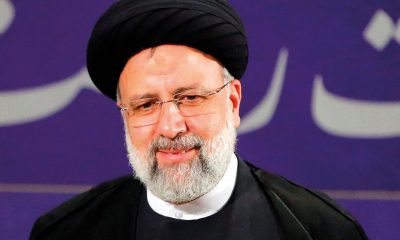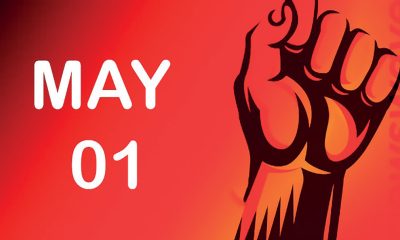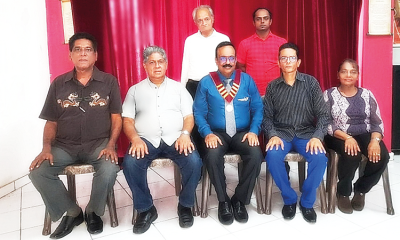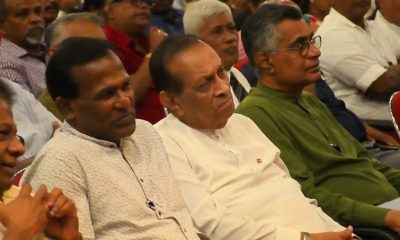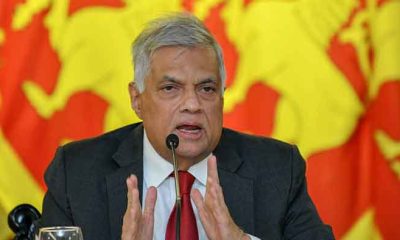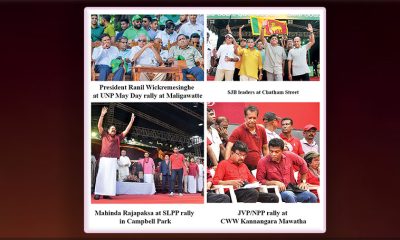Features
What’s in a Suit? That which is substantive can be delivered in a Bush Shirt!

by Rajan Philips
Never mind what Anura Kumara Dissanayake wore in Delhi. Never mind what Ranil Wickremesinghe wears daily. What the people want is not the word salads of sartorial politics by Sunday pundits, but the proffering of substantive politics by contenders for political office. As the pre-election dust takes its own time to settle, two figures are emerging as the primary contenders.
On the right, where he has always been, is Ranil Wickremesinghe. On the left, where he seems inspired to be, is Anura Kumara Dissanayake. If there was any chance of someone racing up the middle, that chance and the politics of that candidate are fast withering. The political house of Sajith Premadasa is a house divided according to insiders and outsiders. Mr. Premadasa will have to put his own house in order before he can be a serious contender for public office.
The impending contest between Ranil Wickremesinghe and Anura Kumara Dissanayake will be a very different one when compared to past presidential elections. First to be noted is the organizational disarray of the mainstream political parties and their electorally opportunistic alliances. The disarray is obvious and needs no elaboration.
It also explains why President Wickremesinghe, the nearly 50-year veteran of a 77 year old party, is still looking for a political launcher for his presidential candidacy. Officially, he will be a UNP candidate with the elephant symbol, but he is looking to be acclaimed as the candidate of a grand alliance. Media columnists are writing about such an alliance, but there are no signs yet of any alliance, let alone a grand one.
The support for President Wickremesinghe is mainly based on his successful stabilization of the economy from where his predecessor left and ran away. Those who are genuinely and perhaps exclusively concerned about the economy do think that Ranil Wickremesinghe should be elected as President to continue managing the economy. But this premise has at least two limitations.
A tentative candidate
One, while it is fair to give Mr. Wickremesinghe credit for what he has done, it would be a stretch to claim that what he has done is something miraculous and that he should contest and be elected President for a new term to continue performing economic miracles. The economy cannot be restored by magic or miracles, and no one should lose sight of the fact that the current stability is primarily due to the moratorium on debt payment. What happens when debt repayment is restarted?
The second limitation to the Wickremesinghe candidacy is that the support for Mr. Wickremesinghe is neither broad nor deep. Otherwise, he should be the one who is topping opinion polls and creating the buzz that Ranil is the man to beat. Mr. Wickremesinghe himself is quite coy about his candidacy. Either he is keeping everyone guessing, or he is guessing himself.
It may be that the President is looking for a broad appeal imploring him to contest the presidential election to keep saving the economy. Similar to the circumstance in which he acceded to the desperate request of Gotabaya Rajapaksa for a helping hand. But there is nothing like that happening now. No appeal by any credible alliance for Ranil to be a candidate. The whole tentativeness of the situation is a symptom of the disarray of the political establishment.
That brings me to the second unique aspect of the upcoming presidential election. That is the emergence of the JVP/NPP as real contender for winning power democratically, and whose unity of purpose and organizational discipline stand in stirring contrast to the opportunism and disarray of the mainstream parties. The JVP’s emergence as a viable contender is as much due to its own maturity as it is due to resonating objective conditions.
The aragalaya that drove Gota away may have turned the tide for the JVP. But it goes beyond that, and it shows the people’s real hunger for an alternative political leadership. And it shows that the people are not warming up to Ranil Wickremesinghe in spite of all the learned views about his capabilities as an economic manager.
AKD’s leadership
The consolidation of the JVP and the emergence of the NPP as its electoral front also owe a great deal to the seemingly collegial leadership of Anura Kumara Dissanayake. He is unique in Sri Lankan politics as the one political leader who has filtered up through the social layers among the Sinhalese without being part of a mainstream political party – the UNP, the SLFP, and later the SLPP. The devolution of political leadership in Sri Lanka – i.e., the transitioning of political leadership from the decadent upper strata of society to the emerging generations – could be a study in itself.
The fact of the matter is that such a transitioning has not been as common in Sri Lanka as it has been in India. There is a long trace of leadership transitioning in India – from the rise of K. Kamaraj as Chief Minister of Madras State (now Tamil Nadu) in 1954, to the ascent of Narendra Modi first as Chief Minister of Gujarat and now the soon to be ‘threepeat’ Prime Minister of India. There is nothing common about their politics, but they represent the shifting of leadership from the upper echelons to the lower strata of India’s hugely stratified society. The example of President Premadasa could be cited as an exception, but it was an exception that could not become a trend.
The JVP and the LTTE interventions could be seen as violent and misplaced efforts to force a transitioning of leadership. Both efforts ended in failure, but the reality now is that even the traditional leadership formations have now imploded. There was a much touted recent transitioning in Tamil political leadership, but that seems to have got mired in legal battles in district courts.
The saving grace here is in the recourse to court battles instead of gun battles. There have been shifts in leadership among the Muslims and estate Tamils, but even the new organizations representing the two communities have become mere appendages to mainstream alliances. They too are suffering from the organizational disarray of their mainstream principals.
In this scheme of unfolding disarray, it is fair to acknowledge the leadership and organizational achievements of Anura Kumara Dissanayake, the JVP and the NPP. This is not to say that they are going to win the upcoming elections and that they are going to provide a pathbreaking new government for Sri Lanka. Those proofs will come in whatever puddings they make.
For now, as a point of political observation, what AKD has done so far needs to be acknowledged. India seems to have done that, and it is irrelevant to the current argument why India may have chosen to do that. More to the point, there has been no Indian invitation yet, not even a hint of it, to the newly elected leader of the ITAK.
The gripe over AKD’s Indian visit is really a symptom of the uneasiness in political circles that are unable to come to grips with the disarray among the mainstream political parties and their alliances. Not to mention that for a host of good and bad reasons, the arrival of the JVP/NPP as a palpable parliamentary force is not palatable to many in the commentating business. It is again a symptom of the mainstream disarray that criticisms of JVP/NPP are emanating almost exclusively outside of parliament and from outside formal political organizations. Conversely, it is this vacuum that the JVP/NPP is filling up much to the irritation of its socio-genital opponents.
Their politics and ours
The task for Anura Kumara Dissanayake and the JVP/NPP is to respond to the sartorial politics of their critics with substantive politics of their own. “Their Politics and Ours,” the title of an old pamphlet that Dr. Colvin R de Silva wrote in the early 1950s, takes a different meaning in the new context in which the JVP/NPP is emerging as a real parliamentary contender.
Dr Colvin was intervening in the perennial debates within the left movement in the heady days of the Old Left. That was then. Now, Anura Kumara Dissanayake does not have to get into polemic battles with anyone on the Left. He is in fact the only one on the Left, electorally speaking. He has to differentiate his politics from that of his media critics.
There is another difference between the heady days of the Old Left and Sri Lanka’s desperate times after the Rajapaksa yugaya. The challenge today is not to advance the cause of socialism but to salvage the economy from the pits that it has fallen into. Sri Lanka’s economic irony cannot be any stalker, in that Sri Lanka and Pakistan are two economic laggards in South Asia that is now seen as the principal growth region for an unevenly sputtering world economy.
India is virtually the sole economic engine of the South Asian region, and the challenge facing Sri Lanka is to get in stride with ongoing regional growth instead of lagging behind it.
The challenge facing JVP/NPP is to generate confidence about its abilities for managing the economy the same way it is demonstrating its abilities for political mobilization. As a political organization it does not have to rely on its leaders to read economic textbooks the way Che Guvera read them after the Cuban revolution.
There are enough economists and economic thinktanks in Sri Lanka and the JVP/NPP should not feel shy about tapping them for ideas and as resources. There should be reaching out to professional resources in a very public way to enhance public confidence at the national level, the same way retired military and police officers are reportedly being enlisted at the electoral district levels.
Besides the economy, the JVP/NPP leadership will have to deal with the question of constitutional reform and clarify its position on what could still be called the island’s national question. On the question of abolishing the executive presidency, Mr. Dissanayake has provided a convincing response: there is no time to do it before the presidential election.
President Wickremesinghe has said the same thing, but the difference between the two is that while Mr. Dissanayake is committed to abolishing the presidency, Mr. Wickremesinghe is not. That is a big difference, and one on which Mr. Dissanayake could and should publicly challenge the interim President.
Features
A plural society requires plural governance

The local government elections that took place last week saw a consolidation of the democratic system in the country. The government followed the rules of elections to a greater extent than its recent predecessors some of whom continue to be active on the political stage. Particularly noteworthy was the absence of the large-scale abuse of state resources, both media and financial, which had become normalised under successive governments in the past four decades. Reports by independent election monitoring organisations made mention of this improvement in the country’s democratic culture.
In a world where democracy is under siege even in long-established democracies, Sri Lanka’s improvement in electoral integrity is cause for optimism. It also offers a reminder that democracy is always a work in progress, ever vulnerable to erosion and needs to be constantly fought for. The strengthening of faith in democracy as a result of these elections is encouraging. The satisfaction expressed by the political parties that contested the elections is a sign that democracy in Sri Lanka is strong. Most of them saw some improvement in their positions from which they took reassurance about their respective futures.
The local government elections also confirmed that the NPP and its core comprising the JVP are no longer at the fringes of the polity. The NPP has established itself as a mainstream party with an all-island presence, and remarkably so to a greater extent than any other political party. This was seen at the general elections, where the NPP won a majority of seats in 21 of the country’s 22 electoral districts. This was a feat no other political party has ever done. This is also a success that is challenging to replicate. At the present local government elections, the NPP was successful in retaining its all-island presence although not to the same degree.
Consolidating Support
Much attention has been given to the relative decline in the ruling party’s vote share from the 61 percent it secured in December’s general election to 43 percent in the local elections. This slippage has been interpreted by some as a sign of waning popularity. However, such a reading overlooks the broader trajectory of political change. Just three years ago, the NPP and its allied parties polled less than five percent nationally. That they now command over 40 percent of the vote represents a profound transformation in voter preferences and political culture. What is even more significant is the stability of this support base, which now surpasses that of any rival. The votes obtained by the NPP at these elections were double those of its nearest rival.
The electoral outcomes in the north and east, which were largely won by parties representing the Tamil and Muslim communities, is a warning signal that ethnic conflict lurks beneath the surface. The success of the minority parties signals the different needs and aspirations of the ethnic and religious minority electorates, and the need for the government to engage more fully with them. Apart from the problems of poverty, lack of development, inadequate access to economic resources and antipathy to excessive corruption that people of the north and east share in common with those in other parts of the country, they also have special problems that other sections of the population do not have. These would include problems of military takeover of their lands, missing persons and persons incarcerated for long periods either without trial or convictions under the draconian Prevention of Terrorism Act (which permits confessions made to security forces to be made admissible for purposes of conviction) and the long time quest for self-rule in the areas of their predominance
The government’s failure to address these longstanding issues with urgency appears to have caused disaffection in electorate in the north and east. While structural change is necessarily complex and slow, delays can be misinterpreted as disinterest or disregard, especially by minorities already accustomed to marginalisation. The lack of visible progress on issues central to minority communities fosters a sense of exclusion and deepens political divides. Even so, it is worth noting that the NPP’s vote in the north and east was not insignificant. It came despite the NPP not tailoring its message to ethnic grievances. The NPP has presented a vision of national reform grounded in shared values of justice, accountability, development, and equality.
Translating electoral gains into meaningful governance will require more than slogans. The failure to swiftly address matters deemed to be important by the people of those areas appears to have cost the NPP votes amongst the ethnic and religious minorities, but even here it is necessary to keep matters in perspective. The NPP came first in terms of seats won in two of the seven electoral districts of the north and east. They came second in five others. The fact that the NPP continued to win significant support indicates that its approach of equity in development and equal rights for all has resonance. This was despite the Tamil and Muslim parties making appeals to the electorate on nationalist or ethnic grounds.
Slow Change
Whether in the north and east or outside it, the government is perceived to be slow in delivering on its promises. In the context of the promise of system change, it can be appreciated that such a change will be resisted tooth and nail by those with vested interests in the continuation of the old system. System change will invariably be resisted at multiple levels. The problem is that the slow pace of change may be seen by ethnic and religious minorities as being due to the disregard of their interests. However, the system change is coming slow not only in the north and east, but also in the entire country.
At the general election in December last year, the NPP won an unprecedented number of parliamentary seats in both the country as well as in the north and east. But it has still to make use of its 2/3 majority to make the changes that its super majority permits it to do. With control of 267 out of 339 local councils, but without outright majorities in most, it must now engage in coalition-building and consensus-seeking if it wishes to govern at the local level. This will be a challenge for a party whose identity has long been built on principled opposition to elite patronage, corruption and abuse of power rather than to governance. General Secretary of the JVP, Tilvin Silva, has signaled a reluctance to form alliances with discredited parties but has expressed openness to working with independent candidates who share the party’s values. This position can and should be extended, especially in the north and east, to include political formations that represent minority communities and have remained outside the tainted mainstream.
In a plural and multi-ethnic society like Sri Lanka, democratic legitimacy and effective governance requires coalition-building. By engaging with locally legitimate minority parties, especially in the north and east, the NPP can engage in principled governance without compromising its core values. This needs to be extended to the local government authorities in the rest of the country as well. As the 19th century English political philosopher John Stuart Mill observed, “The worth of a state in the long run is the worth of the individuals composing it,” and in plural societies, that worth can only be realised through inclusive decision-making.
by Jehan Perera
Features
Commercialising research in Sri Lanka – not really the healthiest thing for research

In the early 2000s, a colleague, returning to Sri Lanka after a decade in a research-heavy first world university, complained to me that ‘there is no research culture in Sri Lanka’. But what exactly does having a ‘research culture’ mean? Is a lot of funding enough? What else has stopped us from working towards a productive and meaningful research culture? A concerted effort has been made to improve the research culture of state universities, though there are debates about how healthy such practices are (there is not much consideration of the same in private ‘universities’ in Sri Lanka but that is a discussion for another time). So, in the 25 years since my colleague bemoaned our situation, what has been happening?
What is a ‘research culture’?
A good research culture would be one where we – academics and students – have the resources to engage productively in research. This would mean infrastructure, training, wholesome mentoring, and that abstract thing called headspace. In a previous Kuppi column, I explained at length some of the issues we face as researchers in Sri Lankan universities, including outdated administrative regulations, poor financial resources, and such aspects. My perspective is from the social sciences, and might be different to other disciplines. Still, I feel that there are at least a few major problems that we all face.
Number one: Money is important.
Take the example American universities. Harvard University, according to Harvard Magazine, “received $686.5 million in federally sponsored research grants” for the fiscal year of 2024 but suddenly find themselves in a bind because of such funds being held back. Research funds in these universities typically goes towards building and maintenance of research labs and institutions, costs of equipment, material and other resources and stipends for graduate and other research assistants, conferences, etc. Without such an infusion of money towards research, the USA would not have been able to attracts (and keeps) the talent and brains of other countries. Without a large amount of money dedicated for research, Sri Lankan state universities, too, will not have the research culture it yearns for. Given the country’s austere economic situation, in the last several years, research funds have come mainly from self-generated funds and treasury funds. Yet, even when research funds are available (they are usually inadequate), we still have some additional problems.
Number two: Unending spools of red tape
In Sri Lankan universities red tape is endless. An MoU with a foreign research institution takes at least a year. Financial regulations surrounding the award and spending of research grants is frustrating.
Here’s a personal anecdote. In 2018, I applied for a small research grant from my university. Several months later, I was told I had been awarded it. It comes to me in installments of not more than Rs 100,000. To receive this installment, I must submit a voucher and wait a few weeks until it passes through various offices and gains various approvals. For mysterious financial reasons, asking for reimbursements is discouraged. Obviously then, if I were working on a time-sensitive study or if I needed a larger amount of money for equipment or research material, I would not be able to use this grant. MY research assistants, transcribers, etc., must be willing to wait for their payments until I receive this advance. In 2022, when I received a second advance, the red tape was even tighter. I was asked to spend the funds and settle accounts – within three weeks. ‘Should I ask my research assistants to do the work and wait a few weeks or months for payment? Or should I ask them not to do work until I get the advance and then finish it within three weeks so I can settle this advance?’ I asked in frustration.
Colleagues, who regularly use university grants, frustratedly go along with it; others may opt to work with organisations outside the university. At a university meeting, a few years ago, set up specifically to discuss how young researchers could be encouraged to do research, a group of senior researchers ended the meeting with a list of administrative and financial problems that need to be resolved if we want to foster ‘a research culture’. These are still unresolved. Here is where academic unions can intervene, though they seem to be more focused on salaries, permits and school quotas. If research is part of an academic’s role and responsibility, a research-friendly academic environment is not a privilege, but a labour issue and also impinges on academic freedom to generate new knowledge.
Number three: Instrumentalist research – a global epidemic
The quality of research is a growing concern, in Sri Lanka and globally. The competitiveness of the global research environment has produced seriously problematic phenomena, such as siphoning funding to ‘trendy’ topics, the predatory publications, predatory conferences, journal paper mills, publications with fake data, etc. Plagiarism, ghost writing and the unethical use of AI products are additional contemporary problems. In Sri Lanka, too, we can observe researchers publishing very fast – doing short studies, trying to publish quickly by sending articles to predatory journals, sending the same article to multiple journals at the same time, etc. Universities want more conferences rather than better conferences. Many universities in Sri Lanka have mandated that their doctoral candidates must publish journal articles before their thesis submission. As a consequence, novice researchers frequently fall prey to predatory journals. Universities have also encouraged faculties or departments to establish journals, which frequently have sub-par peer review.
Alongside this are short-sighted institutional changes. University Business Liankage cells, for instance, were established as part of the last World Bank loan cycle to universities. They are expected to help ‘commercialise’ research and focuses on research that can produce patents, and things that can be sold. Such narrow vision means that the broad swathe of research that is undertaken in universities are unseen and ignored, especially in the humanities and social sciences. A much larger vision could have undertaken the promotion of research rather than commercialisation of it, which can then extend to other types of research.
This brings us to the issue of what types of research is seen as ‘relevant’ or ‘useful’. This is a question that has significant repercussions. In one sense, research is an elitist endeavour. We assume that the public should trust us that public funds assigned for research will be spent on worth-while projects. Yet, not all research has an outcome that shows its worth or timeliness in the short term. Some research may not be understood other than by specialists. Therefore, funds, or time spent on some research projects, are not valued, and might seem a waste, or a privilege, until and unless a need for that knowledge suddenly arises.
A short example suffices. Since the 1970s, research on the structures of Sinhala and Sri Lankan Tamil languages (sound patterns, sentence structures of the spoken versions, etc.) have been nearly at a standstill. The interest in these topics are less, and expertise in these areas were not prioritised in the last 30 years. After all, it is not an area that can produce lucrative patents or obvious contributions to the nation’s development. But with digital technology and AI upon us, the need for systematic knowledge of these languages is sorely evident – digital technologies must be able to work in local languages to become useful to whole populations. Without a knowledge of the structures and sounds of local languages – especially the spoken varieties – people who cannot use English cannot use those devices and platforms. While providing impetus to research such structures, this need also validates utilitarian research.
This then is the problem with espousing instrumental ideologies of research. World Bank policies encourage a tying up between research and the country’s development goals. However, in a country like ours, where state policies are tied to election manifestos, the result is a set of research outputs that are tied to election cycles. If in 2019, the priority was national security, in 2025, it can be ‘Clean Sri Lanka’. Prioritising research linked to short-sighted visions of national development gains us little in the longer-term. At the same time, applying for competitive research grants internationally, which may have research agendas that are not nationally relevant, is problematic. These are issues of research ethics as well.
Concluding thoughts
In moving towards a ‘good research culture’, Sri Lankan state universities have fallen into the trap of adopting some of the problematic trends that have swept through the first world. Yet, since we are behind the times anyway, it is possible for us to see the damaging consequences of those issues, and to adopt the more fruitful processes. A slower, considerate approach to research priorities would be useful for Sri Lanka at this point. It is also a time for collective action to build a better research environment, looking at new relationships and collaborations, and mentoring in caring ways.
(Dr. Kaushalya Perera teaches at the Department of English, University of Colombo)
Kuppi is a politics and pedagogy happening on the margins of the lecture hall that parodies, subverts, and simultaneously reaffirms social hierarchies.
By Kaushalya Perera
Features
Melantha …in the spotlight

 Melantha Perera, who has been associated with many top bands in the past, due to his versatility as a musician, is now enjoying his solo career, as well … as a singer.
Melantha Perera, who has been associated with many top bands in the past, due to his versatility as a musician, is now enjoying his solo career, as well … as a singer.
He was invited to perform at the first ever ‘Noon2Moon’ event, held in Dubai, at The Huddle, CityMax Hotel, on Saturday, 3rd May.
It was 15 hours of non-stop music, featuring several artistes, with Melantha (the only Sri Lankan on the show), doing two sets.
According to reports coming my way, ‘Noon2Moon’ turned out to be the party of the year, with guests staying back till well past 3.00 am, although it was a 12.00 noon to 3.00 am event.

Having Arabic food
Melantha says he enjoyed every minute he spent on stage as the crowd, made up mostly of Indians, loved the setup.
“I included a few Sinhala songs as there were some Sri Lankans, as well, in the scene.”
Allwyn H. Stephen, who is based in the UAE, was overjoyed with the success of ‘Noon2Moon’.
Says Allwyn: “The 1st ever Noon2Moon event in Dubai … yes, we delivered as promised. Thank you to the artistes for the fab entertainment, the staff of The Huddle UAE , the sound engineers, our sponsors, my supporters for sharing and supporting and, most importantly, all those who attended and stayed back till way past 3.00 am.”

Melantha:
Dubai and
then Oman
Allwyn, by the way, came into the showbiz scene, in a big way, when he featured artistes, live on social media, in a programme called TNGlive, during the Covid-19 pandemic.
After his performance in Dubai, Melantha went over to Oman and was involved in a workshop – ‘Workshop with Melantha Perera’, organised by Clifford De Silva, CEO of Music Connection.
The Workshop included guitar, keyboard and singing/vocal training, with hands-on guidance from the legendary Melantha Perera, as stated by the sponsors, Music Connection.
Back in Colombo, Melantha will team up with his band Black Jackets for their regular dates at the Hilton, on Fridays and Sundays, and on Tuesdays and Thursdays at Warehouse, Vauxhall Street.
Melantha also mentioned that Bright Light, Sri Lanka’s first musical band formed entirely by visually impaired youngsters, will give their maiden public performance on 7th June at the MJF Centre Auditorium in Katubadda, Moratuwa.
-

 Latest News6 days ago
Latest News6 days agoNPP win Maharagama Urban Council
-

 Features2 days ago
Features2 days agoSAITM Graduates Overcome Adversity, Excel Despite Challenges
-

 Business5 days ago
Business5 days agoJohn Keells Properties and MullenLowe unveil “Minutes Away”
-

 Sports2 days ago
Sports2 days agoASBC Asian U22 and Youth Boxing Championships from Monday
-

 News2 days ago
News2 days agoDestined to be pope:Brother says Leo XIV always wanted to be a priest
-

 Foreign News3 days ago
Foreign News3 days agoMexico sues Google over ‘Gulf of America’ name change
-
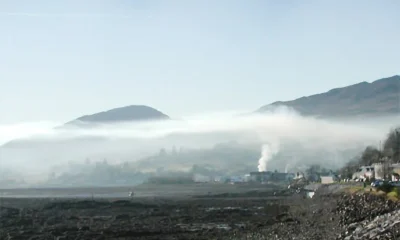
 Opinion5 days ago
Opinion5 days agoRatmalana: An international airport without modern navigational and landing aids
-

 Opinion2 days ago
Opinion2 days agoDrs. Navaratnam’s consultation fee three rupees NOT Rs. 300



